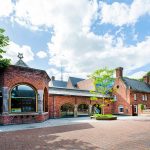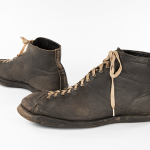After spending 3 nights in Zlin it was time to travel to my next destination – the Egon Schiele Art Centrum (ESAC) in Český Krumlov. This part of the journey involved 3 buses: Zlin to Brno, Brno to Český Budějovice, then on to Krumlov. With all the transfer points it ended up being a 7-hour trip but it was a great opportunity to see the country side.
Cesky Krumlov became a UNESCO World Heritage Site in 1992. I stayed in the Old Town in an atelier provided by the art gallery nestled against the meandering Vltava River. Krumlov was a destination for traveling tribes for hundreds of years. The castle was initially started in the 13th century, then continually added to by successive noble families. I was fortunate to be given a private tour of the castle by its director, including a behind the scenes tour of one of 2 remaining Baroque theatres in Europe and its considerable holding of costumes acquired over the centuries.
One of the most amazing sights are the buildings painted using a trompe-l’oeil technique which imparts a 3D decorative effect on the exteriors of the buildings. As you can see in the accompanying photograph the walls have been painted to give the impression of different styles of brickwork and the figures at the top of the wall of the building at the back appear as sculptures standing inside recessed alcoves.
The ESAC was founded in 1992, opening its doors to the public in 1993. It is housed in a restored 17th century brewery complete with a rabbit warren of rooms, massive wooden beams and very low ceilings. It features artwork by the Austrian artist Egon Schiele whose mother was born in Krumlov. Additonal galleries host paintings, sculptures and installations by other 20thC and contemporary artists.
The exhibition selected to travel to the Czech Republic was Heights of Fashion: A History of the Elevated Foot which was very popular when it originally ran at the BSM for a year and a half starting in the fall of 2001. All the text and accompanying images were sent to the gallery in advance along with showcase material recommendations. The crates of artefacts had arrived a week before me. When I got to the gallery everything was in place. Over the course of 2 ½ days I worked with the ESAC installation team, cleaning showcase lids, unpacking/condition checking/installing artefacts and adjusting light levels. At night I wandered the streets of the old town, checking out the many churches, sampling the local cuisine and wandering through the castle gardens.







